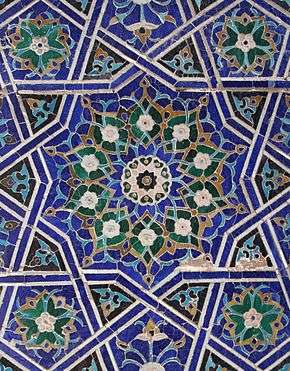Prayer rug
A prayer rug or prayer mat (Arabic: سجادة sajjāda pl. سجاجيد sajājīd, or musallah; Turkish: seccade or namazlık; Persian: جانماز, Urdu: جانماز jānamāz, Bengali: জায়নামাজ jaênamaj) is a piece of fabric, sometimes a pile carpet, used by Muslims, placed between the ground and the worshipper for cleanliness during the various positions of Islamic prayer. These involve prostration and sitting on the ground. A Muslim must perform wudu (ablution) before prayer, and must pray in a clean place. Many new prayer mats are manufactured by weavers in a factory. The design of a prayer mat is based on the village it came from and its weaver.
When praying, a niche, representing the mihrab of a mosque, at the top of the mat must be pointed to the Islamic center for prayer, Mecca. All Muslims are required to know the qibla or direction towards Mecca from their home or where they are while travelling.
Features and use
The prayer rug has a very strong symbolic meaning and traditionally taken care of in a holy manner. It is disrespectful for one to place a prayer mat in a dirty location (as Muslims have to be clean to show their respect to God) or throw it around in a disrespectful manner. The prayer mat is traditionally woven with a rectangular design, typically made asymmetrical by the niche at the head end. Within the rectangle one usually finds images of Islamic symbols and architecture. In some cultures decorations not only are important but also have a deep sense of value in the design of the prayer rug.
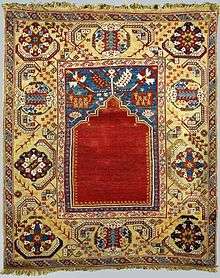
A prayer rug is characterized by a niche at one end, representing the mihrab in every mosque, a directional point to direct the worshipper towards Mecca. Many rugs also show one or more mosque lamps, a reference to the Verse of Light in the Qur'an. Specific mosques are sometimes shown; some of the most popular examples include the mosques in Mecca, Medina, and especially Jerusalem. Decorations not only play a role in imagery but serve the worshipper as aids to memory. Some of the examples include a comb and pitcher, which is a reminder for Muslims to wash their hands and for men to comb their hair before performing prayer. Another important use for decorations is to aid newly converted Muslims by stitching decorative hands on the prayer mat where the hands should be placed when performing prayer.
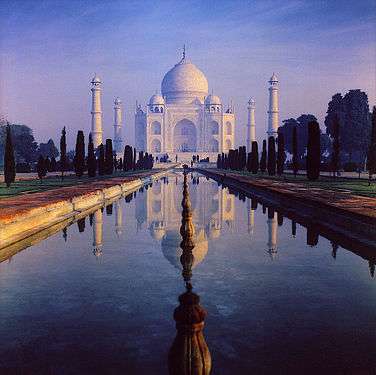 |
| Part of a series on |
| Islamic culture |
|---|
| Architecture |
| Art |
| Dress |
| Holidays |
| Literature |
| Music |
| Theatre |
|
Prayer rugs are usually made in the towns or villages of the communities who use them and are often named after the origins of those who deal and collect them. The exact pattern will vary greatly by original weavers and the different materials used. Some may have patterns, dyes and materials that are traditional/native to the region in which they were made. Prayer rugs' patterns generally have a niche at the top, which is turned to face Mecca. During prayer the supplicant kneels at the base of the rug and places his or her hands at either side of the niche at the top of the rug, his or her forehead touching the niche. Typical prayer rug sizes are approximately 2.5 ft × 4 ft (0.76 m × 1.22 m) - 4 ft × 6 ft (1.2 m × 1.8 m), enough to kneel above the fringe on one end and bend down and place the head on the other.
Some countries produce textiles with prayer rug patterns for export. Many modern prayer rugs are strictly commercial pieces made in large numbers to sell on an international market or tourist trade.
There are many prayer rugs in existence today that have been taken care of for more than 100 years.[1] In most cases, they have been immediately and carefully rolled after each prayer.
The Transylvanian miracle: Islamic rugs in Protestant Churches
The Saxon Lutheran Churches, parish storerooms and museums of Transylvania safeguard about four hundred Anatolian rugs, dating from the late-15th to the mid-18th century. They form the richest and best-preserved corpus of prayer-format rugs of Ottoman period outside Turkey.
Without attempting a résumé of the region’s complex history, Transylvania (like the other Romanian principalities of Moldavia and Wallachia) never came under direct Turkish occupation. Until 1699 it had the status of an autonomous Principality, maintaining the Christian religion and own administration but paying tribute to the Ottoman Porte. By contrast, following the Battle of Mohacs in 1526, part of Hungary was designated a Pashalik and was under Turkish occupation for over a century and a half.
Rugs came into the ownership of the Reformed Churches, mainly as pious donations from parishioners, benefactors or guilds. In the 16th century, with the coming of the Reformation, the number of figurative images inside the churches was drastically reduced as people followed the ten commandments earnestly: "You shall not make for yourself a carved image..., you shall not bow down to them or serve them". Frescoes were white-washed or destroyed, and the many somptuous winged altar-pieces were removed maintaining exclusively the main altar piece. The recently converted parishioners thus perceived the church as a large, cold and empty space that needed warming up and a welcoming touch. Traces of the mural decoration were found during modern restorations in some Protestant Churches as for instance at Malâncrav.
In this situation the Oriental rugs, created in a world that was spiritually different from Christianity, found their place in the Reformed churches which were to become their main custodians. The removal from the commercial circuit and the fact that they were used to decorate the walls, the pews and the balconies but not on the floor was crucial for their conservation over the years. This is unique and quite extraordinary if we consider that the Ottoman Empire heavily dominated the region at that time. This fact confirms not only the traditional religious tolerance of Transylvanians but also the capacity of Oriental rugs to bridge different cultures.
Gallery
 Typical manufactured prayer mat showing the Kaaba
Typical manufactured prayer mat showing the Kaaba Early 20th-century Siirt Battaniyesi. Child's mohair prayer rug/blanket
Early 20th-century Siirt Battaniyesi. Child's mohair prayer rug/blanket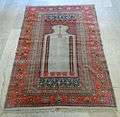 Ottoman Era Kayseri silk prayer rug. Circa 1880s
Ottoman Era Kayseri silk prayer rug. Circa 1880s Vintage Konya prayer seccade
Vintage Konya prayer seccade Antique Gaziantep double prayer rug
Antique Gaziantep double prayer rug Ancient Kirşehir prayer rug in the Tilavet room; Mevlâna Mausoleum, Konya
Ancient Kirşehir prayer rug in the Tilavet room; Mevlâna Mausoleum, Konya Turkish prayer rug
Turkish prayer rug Fachralo Kazak prayer rug, late 19th century
Fachralo Kazak prayer rug, late 19th century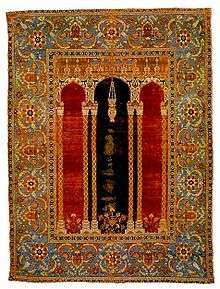 The James F. Ballard late 16th century Bursa prayer rug
The James F. Ballard late 16th century Bursa prayer rug Caucasian prayer rug, Shirvan
Caucasian prayer rug, Shirvan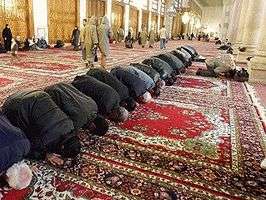 Umayyad Mosque prayer rug saph, Damascus
Umayyad Mosque prayer rug saph, Damascus Muslim prostrating on prayer rug. Artist Charles Bargue
Muslim prostrating on prayer rug. Artist Charles Bargue The Sultan Ahmet Camii prayer rug saph, "The Blue Mosque", Istanbul
The Sultan Ahmet Camii prayer rug saph, "The Blue Mosque", Istanbul Vintage Balouch prayer rug
Vintage Balouch prayer rug Prayer rug Afghanistan
Prayer rug Afghanistan Antique Anatolian prayer rug
Antique Anatolian prayer rug "Re-entrant" or "keyhole" prayer mat, also called a Bellini carpet, Anatolia, late 15th to early 16th century. The mat symbolically describes the environment of a mosque, with the entrance (the "keyhole"), and the mihrab (the forward corner) with its hanging mosque lamps.
"Re-entrant" or "keyhole" prayer mat, also called a Bellini carpet, Anatolia, late 15th to early 16th century. The mat symbolically describes the environment of a mosque, with the entrance (the "keyhole"), and the mihrab (the forward corner) with its hanging mosque lamps.
- Kayseri prayer rug,Anatolia Turkey
See also
- Persian embroidery
- Podruchnik, a cushion for worshipper's hands among Russian Old Believer Christians
- Oriental carpets in Renaissance painting
- Islamic art
References
- "prayer rug." Encyclopædia Britannica. 2008. Encyclopædia Britannica Online. 23 Oct. 2008 <http://www.britannica.com/EBchecked/topic/474169/prayer-rug.
- Faid, Abbo Muhammed Samir. "Islam" All Experts. 16 Mar 2005. <http://www.liu.edu/cwis/cwp/library/workshop/citmla.htm>
| Wikimedia Commons has media related to Prayer rugs. |

